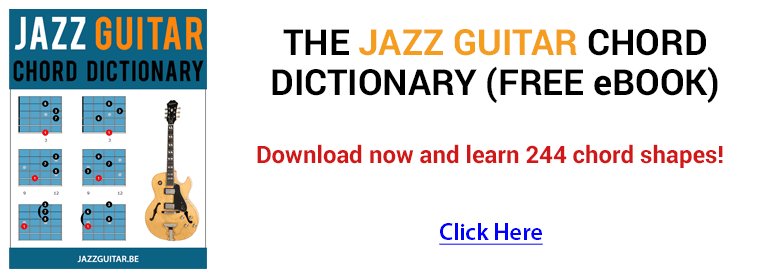-
Hi, I have a new book from John Petrucci who advises to practice arpeggios:
Am7 , second position
Am7, fifth position
Am7, seventh position
Am7, twelfth position
what's does this mean?
Is this about the number of the fretboard (for example position of Am7 on second fret) or not?
Please help me to understand thank you
-
09-05-2020 03:58 PM
-
Yes, position refers to where your first finger is. 2nd position means first finger is at second fret.
Your pinky is on 5th fret, the "A" note on low E string. Arpeggio goes off to the left, and you can cover 2 octaves. A C E G.
Fifth position, your first finger is on that "A" and you move to your right (mostly).
Seventh position, the "A" is on the D string.
Twelfth position. The "A" is on the A string. Look at a fretboard diagram, and find the other notes.
-
What about the 9th position?
-
Yes, thank you for your answer it 's very help me
-
the ninth position is a combination with the 7th and the 12th position ('cause the 11th fret have only altered note) if you know the 7th and the 12th position so you konw the 9th position too.
Best regards
-
If you add the 9th position Am7 arpeggio you have the fingering for the arp on the 6th degree of Jimmy Bruno's shape 2 for the tonal center ( key) of C.
I think it's helpful to have a context in which to use an arpeggio. The first four listed above match Bruno's shapes 5, 6, 7 and 3 respectively. Again, C tonal center.
YMMV, but it was Jimmy's approach that unlocked the fretboard for me so that's how I map the world.
-
I agree with you all positions are important,
but my question was find Am7 in only 4 postions (2,5,7 and 12) because on my John Petrucci's book he advise to learn this 4 positions, that's all.
Thank you to your understanding , my question was not in generally but in this specific case.
-
OK. For jazz you should know at least 7 one-octave fingerings for the mi7th arpeggio - in root position.
Two starting fingers for strings 6,5,4
One starting finger for string 3*
For the mi7th arpeggio:
Starting fingers are 1 and 4 for strings 6 and 5,
Starting fingers 1 and 3 for string 4
Starting finger 1 for string 3
*
Regarding string 3, you can also play the arpeggio from the 3rd finger but won't be able to play the root at the octave level, in position. That should not stop you from also playing that fingering. So, that makes 8 one-octave root position fingerings.
Last edited by GTRMan; 09-17-2020 at 09:52 AM.
-
I don't really understand your explaination for the Mim7
do you mean playing only 4 note all along the fretboard on different positions ? or you mean "box" of Mim7 arpeggio ?
So for you what is the first string the low E string or the High e string ?
I am novice in guitar.
Thank you for your answer, it's very helping for me to unlocked the fretaboard quickly
-
Can you explain to me with the example of Am7 arpeggio please ?
thank you so much
-
 Originally Posted by pow
Originally Posted by pow
Yes - one-octave arpeggios have 4 notes (R,3,5,7) or five if you repeat the root at the octave level.
On the guitar the "first string" is the high E string.
For jazz you need to know the one-octave fingerings to successfully articulate/navigate fast harmonic rhythm, among other reasons. You can combine them to form two-octave fingerings, either in position or shifting to a higher or lower position for the higher or lower octave.
-
If it's still not clear I can upload a diagram...
 Originally Posted by pow
Originally Posted by pow
-
Example: 2nd position (I'd say 2nd fret) Am7 arps:
The rest are left as an exercise for the interested student.Code:||---|---|---|---|---| ||---|---|---|---|---| ||---|---|---|---|---| ||---|-E-|---|---|-G-| ||---|---|-C-|---|---| ||---|---|---|---|-A-| ||---|---|-G-|---|(A)| ||---|---|---|---|-E-| ||---|-A-|---|---|-C-| ||---|---|---|---|---| ||---|---|---|---|---| ||---|---|---|---|---|
-
Thank you so much GTRMAN and BIGDADDYLOVESHANDLES
It's more clear now.
I have a other question, have you a memo technic trick to see notes on fretboard quickly ?
if you have any advise to unlocked fretboard definitively thank you
-
That's a big one. Have you read The Advancing Guitarist?
There a many little things that you can do. Here are a couple;
Name a note like "C", then play it in every location on the fret board that exists. Use octave shapes and you will traverse the neck quickly. Then change it up by playing every location for a certain frequency of C. Example, only play "middle C"
Other tricks - play scales, modes, chords, arpeggios, and progressions (like various II-V-I) around the circle of fifths (C, F, Bb, Eb, etc.).
-
I don't think there are shortcuts. When you play, slower can be better -- think of the note as you play it, rather than muscle memory lick playing.
 Originally Posted by pow
Originally Posted by pow
Learning a fretboard system like CAGED helps. So does sight reading.
-
Yeah, sight read some simple things, but play them in different positions. That will challenge you. Start in the key of C until you get the hang of it.
 Originally Posted by BigDaddyLoveHandles
Originally Posted by BigDaddyLoveHandles
-
what is the advanced guitarist ? (give me reference if you want)
i have learned all note on the neck but when i play it was different as i've forget all notes it's not my brain who play but my ears and the probleme is my ear don't know what the note is (i have learned by the past note do ré mi fa sol la si do and no A B C D E F G ) it's so difficult to me to transcribe and ear the note , i don't know if you know what i say.
I know music theory, i was pianist but in piano i see the note and understand the sound with in , but in guitar it's so different and i would have this facility to understand and see note like on piano.
-
The Advancing Guitarist is a book, author is Mick Goodrick. Should be available at Amazon.com
William Leavitt's guitar method is very helpful for reading and fret board learning as well. Check out Volume 2. He has several reading books too. His fingering system is different from CAGED or three notes per string though, just FYI. You can work around that by using your preferred system though. The notes are the notes.
Both Goodrick and Leavitt were Berklee professors.
-
Maybe this is usefull?
-
Or this.
-
thank you for all this precision and reference book
have a good evening
Thank you to Marcel_A to give fretboard map in Am7
-
no problem, but for practical use i think the one from gtr is more usefull.
-
Looks like an eye chart to me.
 Originally Posted by Marcel_A
Originally Posted by Marcel_A

But seriously I think it's useful to picture both 1-octave and 2-octave forms as such. And then there is the "all arpeggio notes in position across six strings view" too. All three have their use and focus. It's the 6 string view that may have led to the overlooking of the form in the 9th position. Everything kind of runs together in that view, or so it seems to me.
But whatever works.Last edited by GTRMan; 09-17-2020 at 05:35 PM.
-
Thank you for your work !
GtrMan great it's so clear
And if i understand these "pattern" of all positions can work in other key too , right ?
is this a standard kind of pattern of minor7 arpeggios ?
John Petrucci was Berklee student and i want to know if this kind of learning minor 7 arpeggios is the standard method to learn it,thank you.
I answer tomorrow i'm from France. See you




 Reply With Quote
Reply With Quote







Peter Sprague & Leonard Patton "Can't Find My Way...
Today, 07:47 PM in The Songs